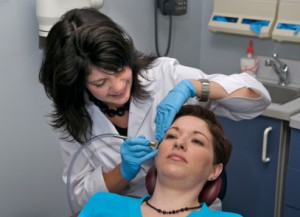TCA skin peels can reduce the appearance of fine lines and wrinkles, blemishes and scarring. Mild TCA peels can be used to treat acne. But chemical peels aren’t for everyone. Here are some alternatives to the TCA skin peel.
Dermabrasion as a TCA Skin Peel Alternative
Dermabrasion is a skin resurfacing technique that could be used in place of a TCA peel. It can smooth out wrinkles and remove scars and precancerous growths. Dermabrasion literally scrapes off the skin’s upper layers, rather than dissolving them like a chemical peel.
Like chemical peels, dermabrasion may not be appropriate for those with dark skin. The risks of dermabrasion include permanent skin discoloration that can make skin darker, lighter or blotchy. Dermabrasion carries a risk of skin infection, and can cause scarring.
Dermabrasion is a surgical procedure, so preparing for it can be more complicated than preparing for a TCA skin peel. You may need to follow dietary guidelines prior to your procedure, and your dermatologist may prescribe medications to help prepare your skin and body for dermabrasion. You’ll probably be asked to stop smoking at least two weeks before dermabrasion.
For most dermabrasion procedures, local anesthetic is all that’s required. If your skin damage is severe, your dermatologist may decide to put you under general anesthetic.
Dermabrasion usually takes less than an hour to perform. A plastic surgeon will use dermaplaning tools, such as a motorized wire brush, to scrape away the surface of the skin. Afterward, you’ll experience significant swelling and inflammation. You may need pain relievers to help with post-treatment pain. You’ll probably need to stay home from work for at least two weeks, and you may not be able to fully resume normal activities, such as sports, for four to six weeks. You’ll need to wear sunblock on the area every day for six months to one year.
Laser Resurfacing as a TCA Skin Peel Alternative
Laser resurfacing is another treatment that can produce results similar to those of a TCA skin peel. You may still need to use skin lightening creams for four to six weeks before your laser resurfacing treatment. Your dermatologist may recommend medications to help your body prepare for laser resurfacing.
Laser resurfacing is usually performed as an outpatient procedure under local anesthetic. The procedure itself lasts no longer than an hour an a half. It’s typically much shorter, however. The length of the procedure depends on the size of your intended treatment area. You may need multiple laser resurfacing treatments to reach your desired results.
The side effects of laser resurfacing include swelling and discomfort. Just like with a TCA peel, your skin will form a hard, brown crust within the first few days after the procedure. This crust will gradually flake off, revealing bright pink new skin beneath. You’ll need to keep your skin clean and most while it heals. Recovery usually takes about ten days.
The risks of laser resurfacing include scarring, burns, permanent discoloration of the skin, and skin infections. Rarely, laser resurfacing can awaken dormant viruses in the body, leading to a flare-up of illness. Your dermatologist may prescribe anti-virals prior to the procedure to prevent this occurrence.

0 Comments until now.
Comment!